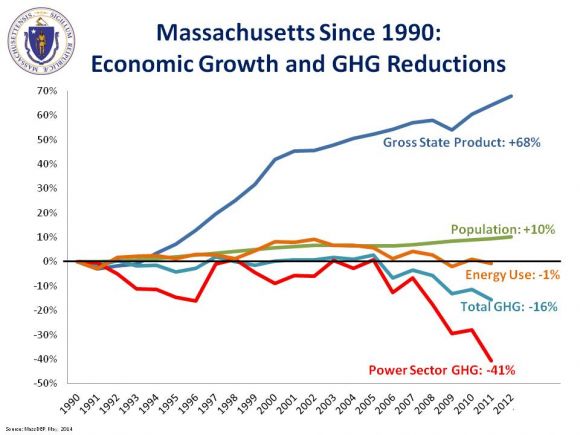In early December, Matt Golden published an article at Greentech Media on why top-down efficiency programs don't work, singling out Massachusetts as an example.
Instead of asking what’s wrong in Massachusetts, the article should be asking what’s right.
The piece left out some important facts that are necessary to understand the whole picture. Massachusetts is first in the nation for energy efficiency for a reason. It delivers more efficiency based on a percentage of energy sales than any other state in the country.
Does Massachusetts pay more for the savings achieved? Yes, it does, because policies and programs in the state achieve deeper and broader energy savings than any other state, as well. And these savings are measured and documented using strong third-party evaluation. While there are still significantly more savings to be achieved, Massachusetts is well beyond the early-adoption stage.
Massachusetts has embarked on a plan to deliver deep and permanent energy savings that are less expensive than the alternative of generating and delivering electrons or therms of gas. This “all cost-effective” mandate that Massachusetts enacted in 2008 through the Green Communities Act means that the state has been doing and spending more to implement energy efficiency.
Massachusetts had its early adopters more than a decade ago, thanks to many years of early-stage programs. Today, utility-run and third-party energy efficiency programs serve thousands of residential and commercial customers annually, including low- and moderate-income customers, as well as small businesses and industries, many of which are benefiting from more advanced technologies that are more broadly available due to these programs. The result of this investment is real and impressive.
The “all cost-effective” mandate means that Massachusetts should increase energy efficiency spending as long as the savings customers are realizing are greater than the costs of achieving them. That has been the case to date. At the same time, Massachusetts is realizing more savings, increased jobs and economic growth, contractor involvement and lower energy costs, thanks to policies promoting all cost-effective energy efficiency.
As shown in the chart above, even as energy use has declined over the last twenty years, gross state product has grown by 68 percent and population has increased by 10 percent. Across New England, energy efficiency and demand response, with Massachusetts leading the charge, have deferred the need for $400 million of transmission investment in New England.
From a jobs perspective, more than 600 contractors in the residential sector alone are driving success in their businesses, adding staff at an amazing rate that is expanding the clean energy economy significantly in the state. Across all sectors, energy efficiency employs more than 65,000 workers in Massachusetts, fueling much of the growth in the state’s clean energy sector, which has grown 74 percent in the last four years.
Economic assessments of Massachusetts’ energy efficiency policies further prove the significant benefits. The Massachusetts Energy Efficiency Advisory Council found that on average each dollar invested in energy efficiency returned $4.17 in benefits to the consumer. For businesses, the results are even more impressive, as business participants received an average of $5.10 in benefits for that same invested dollar.
Additionally, a study from the Analysis Group conducted earlier this year showed that the Green Communities Act provides $1.2 billion in net economic benefits, including more than $155 million in state and local taxes and an added 16,000 jobs.
Should Massachusetts look for ways to reduce the costs per unit of energy efficiency? Of course, and it is. But in doing so, it should build on the tremendous success it has achieved to date.
In Massachusetts, the "top-down" program in the residential sector has enabled the market for both insulation contractors and home performance contractors to grow and succeed. The largest competitive home performance contractor in the country, Next Step Living, started in Massachusetts and continues to thrive here. It has more than 850 employees and is expanding.
And when it comes to creative financing, in 2014 Massachusetts through its Heat Loan program will bring in more than $100 million in private financing to enable more than 11,000 homeowners to complete work on their homes.
As Massachusetts heads into what should be its fifth year of ranking first in the country in energy efficiency, it is exploring innovative financing and delivery models for even greater success. Other states should look to the Massachusetts model as they strive for the same results.
***
Peter Rothstein is president of the New England Clean Energy Council.




